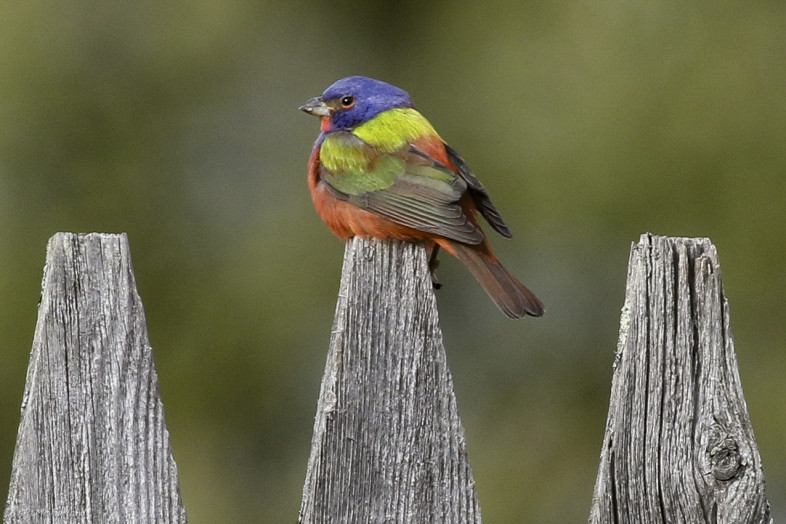Bird watchers are flocking to Pittsfield, Vermont as news spreads of a male Painted Bunting visiting feeders at several residences there. This represents the sixth state record for the species according to the Vermont Bird Records Committee (VBRC). The first accepted report by the VBRC was submitted by Karl & Winifred Droge. They described a pair in Danby on 11-13 May 1993. The first record with a photograph was by Susan Klein in Shelburne on 6 May 1997. Three additional reports have since been accepted by the committee. A complete map of records can be viewed on Vermont eBird, a project of the Vermont Atlas of Life.
Unfortunately, the bird seems to have an injured or deformed foot. A similar individual wintered in Connecticut for several years with a similarly deformed foot. This bird disappeared around March 14. The bird in Pittsfield was first discovered on March 16, leading to speculation that this might actually be the bird from Connecticut. However, the Connecticut bird was back at its feeder yesterday.
A relatively common finch, Painted Buntings breed in the coastal Southeast and in the south-central U.S., where they often come to feeders. They are caught and sold illegally as cage birds, particularly in Mexico and the Caribbean, a practice that puts pressure on their breeding populations.
Comments (9)
Pingbacks (1)
-
[…] have solely been six recorded sightings of the chook within the state, in accordance with the Vermont Center for Ecostudies. But the finch is a standard sight within the south. They breed within the coastal Southeast and […]


I spoke with Dave Winston, the birder in CT who had a painted bunting coming to his feeder. His bird was back at his feeder yesterday. So they’re definitely two different birds – both with injured left legs. Quite the coincidence.
Well, there goes that part of the excitement! Thanks Taj. It would have been wild for sure, but what are the odds of two birds with the same sort of injury like this? I guess we now know…pretty good odds.
I think the bird here in VT has a right leg issue, not left. See my comment below and new photo.
Here’s an image that shows the right foot more closely. It looks like bumblefoot or scaly-leg disease to me. https://www.flickr.com/photos/vtebird/25819962051/
Perhaps the birds are related…I wonder what Charles Darwin would speculate…two directionally challenged birds with issues with their feet…
I think we can call them “directionally challenged”, only because we know a priori that there isn’t a Painted Bunting population in Vermont. From the bird’s prospective, he is likely attempting to locate a new-to-him population of buntings. Swapping genes between populations is a vital process to maintain genetic diversity and to reduce inbreeding within a population, and lots of studies have documented a female novel-phenotype preference. So I think we could make the argument that this type of exploratory behavior is indeed adaptive (in an evolutionary sense), but risky. Think of the first Scarlet Tanager who decided to explore Vermont after the glaciers receded, or the first opossum to cross into North America during the Great American Interchange.
There was one at our feet in Waterbury yesterday!!!
Wow! This is very rare. Can you submit an image for the records to Vermont eBird or Vermont Atlas of Life on iNaturalist?
https://ebird.org/vt/home
https://www.inaturalist.org/projects/vermont-atlas-of-life
Here’s map on VT eBird for the species:https://ebird.org/vt/map/paibun?neg=true&env.minX=-76.54387922656247&env.minY=42.35316969536424&env.maxX=-68.35906477343747&env.maxY=45.374052396872536&zh=true&gp=false&ev=Z&mr=1-12&bmo=1&emo=12&yr=all&byr=1900&eyr=2019
Here’s the species account: https://ebird.org/vt/species/paibun
I sighted a painted bunting at my bird feeder late May, 2020 in South Burlington, VT. I wasn’t quick enough to get a picture and I was disapointed that he didn’t return so I might snap one. I came across an article in the Washington Post, posted Jan 3, 2021 regarding a sighting in Maryland. It reminded me of my sighting and confirmed what I saw last spring! It was a thrill to see.